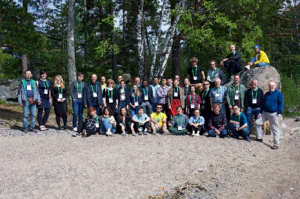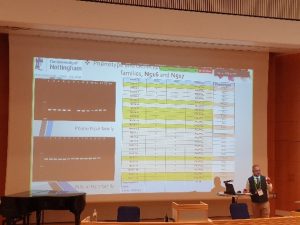August 25, 2022, by sbzlhs
‘Petunia’s friends’ – a wonderful renunion for plant researchers
I am Mohamed Abdulla originally from Libya. I have been studying at The University of Nottingham since 2015. BSc, MSc and a PhD here at the School of Plant Sciences.
I would like to express my great appreciation to UON Researcher Academy for their CTTF Award and the Lamming Travel Award (School of Biosciences) which helped enable me to participate in the 19th World Petunia Days in Helsinki, Finland, where I gave a great presentation.
The conference
This year, the conference was face to face after it was only online for the last two years because of the Covid-19 pandemic. As per its name, the World Petunia Day’s only focus is on the beautiful flowering plant Petunia.
Petunia is one of the most popular cultivated garden bedding flowering plants worldwide. It has large colourful flowers with clear organ morphology. You can see Petunias with colourful flowers hanging in baskets outside houses and shops. The genus Petunia was established by Jussieuin in 1803, and it originates from the eastern side of South America including Brazil and Uruguay. It belongs to the Solanaceae family. Petunia hybrida named because of the commercial Petunia cultivars as well as the laboratory lines are known to have a hybrid origin. It is a consensus that P. hybrida has arisen from hybridization in early 19th century between the self-incompatible species P. integrifolia (purple bee-pollinated) and the self-compatible species P. axillaris (white hawkmoth-pollinated).
“It was an excellent opportunity to meet other Petunia researchers from all over Europe, The UK, USA and Egypt. We all gathered after 2 years of just online meetings because of the pandemic. The experience was just so great.”
The World Petunia Days conference this year was a 3 days event with a wide variety of topics under discussion all applying their research on Petunia. It was held at the fabulous hotel Rantapuito which was has it is own beach and pier with great nature views. The program was well organised by Petunia colleagues and researchers at the University of Helsinki. The schedule was also organised with plenty of breaks which gave a great opportunity for chats and discussions. It also included breakfast and lunchtimes! I am glad that I attended together with my supervisor which was a really great experience. There were about 40 presentations ranging from genetics to flower colours and productions. It was an excellent opportunity to meet other Petunia researchers from all over Europe, the UK, USA and Egypt after 2 years of only having online meetings because of the pandemic. The experience was just so great. There were casual visits to the city of Helsinki, with a great dinner on the first day together. We also took a cruise to the beautiful islands near the capital, and later I visited the capital library in Helsinki. I really liked the idea that this library is publicly funded and offers free services to the public so that knowledge grows. The conference also had a great social program, and the fantastic farewell two course dinner was held in the impressive lobby of the hotel.
The next World Petunia Days conference will take place in Italy July 2023 and I hope to attend again to present the next stage of my PhD project and meet the great researchers and Petunia’s friends again.
My research
Petunia hybrida and its wild relatives are in focus as a suitable model to investigate the fascinating phenomenon known as Self-Incompatibility (SI). SI provides the pistil of a flower with the ability to distinguish between self and non-self-pollen and results either in the inhibition of germination of self-pollen on the stigmatic surface or in the inhibition of growth of self-pollen tubes in the style. Self-incompatibility (SI) in flowering plants is identified as a genetic mechanism by which self-fertilisation is prevented, thereby a high degree of heterozygosity is maintained. This phenomenon allows the plant to be able to recognise its own pollen and reject it by arresting pollen tube growth through the style and consequently preventing inbreeding. Inbreeding can reduce the fitness of a progeny. SI is one of reproductive strategies which are adopted by such hermaphroditic plants in order to promote outcrosses. SI has a significant role in shaping both the spatial and temporal distribution of genetic diversity among flowering plants as it maintains the genetic polymorphism within a population. Non-self-fertilisation can also promote the selection of favourable phenotypes within the species.
My PhD research is looking at this phenomenon. How can the female part of the Petunia flower (The Pistil) know if the male part (The Pollen) is self or non-self so to accept or reject it?. That is a really powerful aspect of the flower. the specificity determinants of self/non-self recognition of SI is controlled by two classes of polymorphic genes at the S-locus. These determinants are a single S-RNase gene and multiple SLFs genes which controls the specificity of pistil and pollen, respectively. The rejection of self-pollen occurs during the pollen tube growth and S-RNase activity in the style leads to pollen RNA degradation by its cytotoxic enzyme activity in self-pollen tubes. The SLF proteins function as a component of E3 ubiquitin ligase complex and they are involved in the specific degradation of non-self S-RNases.
In previous studies, a number of self-incompatible P. hybrida lines were studied and it was revealed that in some cases P. hybrida became self-compatible (SC). This typically resulted in intermediate seed numbers and was called Pseudo Self-Compatibility (PSC). We have tested the genetic basis of a breakdown of SI resulting from crosses between Petunia inflata and Petunia hybrida. Genotypic and phenotypic analysis was done on plants which carry the S-alleles: PhS3 and PiSd. We show that, our novel PiSd allele is related to the breakdown of SI. Petunia plants that inherited the novel PiSd allele became SC. Based on reciprocal crosses it was shown that the breakdown of SI associated with the Sd allele is due to the pollen part. Further investigation will require the identification of SLF genes for the Sd allele.
Mohamed.Abdulla@nottingham.ac.uk
Plant and Crop Science Division, School of Biosciences, University of Nottingham, UK.
Bani Walid University, Libya.
No comments yet, fill out a comment to be the first





Leave a Reply